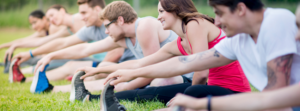Stroke recovery often involves extensive rehabilitation to regain lost motor functions, including the ability to walk or improve gait. One of the critical aspects of this rehabilitation is gait training, which focuses on improving the patterns and mechanics of walking. This guide will walk you through the essential gait training exercises that can aid in stroke recovery, specifically highlighting the 10 best gait exercises for optimal results.
Understanding Gait Training
Gait training involves a series of exercises and techniques designed to help individuals re-learn how to walk correctly after a stroke. The goal is to enhance balance, strength, and coordination, ultimately leading to improved mobility. Proper gait training can significantly impact the quality of life for stroke survivors, helping them regain independence and confidence.

1. Heel-to-Toe Walk
The heel-to-toe walk is an effective exercise to improve balance and coordination. Start by standing upright with your feet together. Take a step forward, placing your heel directly in front of your toes from the previous step. Focus on maintaining a straight line and keeping your balance as you progress. This exercise helps improve the alignment and stability of your gait.
2. Marching in Place
Marching in place is a fundamental exercise that strengthens the muscles used in walking. Begin by standing with your feet hip-width apart. Lift one knee as high as possible while keeping your upper body straight. Alternate legs in a marching motion, ensuring that each lift is controlled and deliberate. This exercise enhances hip flexor strength and improves overall leg mobility.
3. Side-Stepping
Side-stepping is crucial for improving lateral movement and balance. Stand with your feet together, then take a step to the side with your right foot, followed by your left foot, bringing it back to the starting position. Repeat this movement, focusing on smooth and controlled steps. Side-stepping helps strengthen the muscles used for balance and coordination during walking.
4. Toe Taps
Toe taps are designed to improve ankle flexibility and strength. Sit in a chair with your feet flat on the floor. Lift your toes towards your shins while keeping your heels on the ground. Tap your toes up and down, focusing on controlled movements. This exercise enhances the dorsiflexion of the ankle, which is essential for a proper walking gait.
5. Step-Ups
Step-ups help build leg strength and improve the stepping motion required for walking. Use a sturdy step or platform and stand in front of it. Step up with your right foot, followed by your left foot, then step back down starting with your right foot. Repeat the exercise, focusing on smooth, even steps. Step-ups strengthen the quadriceps, hamstrings, and glutes, which are critical for effective gait.
6. Wall Push-Ups
Wall push-ups are an excellent way to enhance upper body strength, which supports overall gait stability. Stand facing a wall with your hands placed at shoulder height. Lean towards the wall, bending your elbows, and then push back to the starting position. This exercise strengthens the arms and shoulders, aiding in better balance and support during walking.
7. Single-Leg Stands
Single-leg stands improve balance and stability by challenging your ability to support weight on one leg. Stand next to a chair or wall for support if needed. Lift one leg and hold the position for several seconds before switching to the other leg. This exercise enhances the strength of your stabilizing muscles and promotes better control of your gait.
8. Treadmill Walking
Walking on a treadmill allows for controlled gait training and is particularly useful for stroke recovery. Start with a slow speed and focus on maintaining a steady, rhythmic walking pattern. Gradually increase the speed and duration as your endurance improves. Treadmill walking helps simulate real-world walking conditions and supports cardiovascular health.
9. Toe Walking
Toe walking can help strengthen the calf muscles and improve balance. Stand with your feet hip-width apart and rise onto the balls of your feet, lifting your heels off the ground. Walk forward on your toes for a short distance, then return to a regular walking position. This exercise enhances ankle stability and calf strength.
10. High Knees
High knees are effective for improving leg strength and coordination. Stand with your feet hip-width apart and lift one knee as high as possible towards your chest. Alternate legs in a controlled motion, ensuring that each lift is deliberate. High knees help build strength in the hip flexors and improve overall gait mechanics.
Conclusion
Incorporating these “10 best gait exercises” into your rehabilitation routine can significantly enhance your stroke recovery process. Each exercise targets different aspects of gait training, from balance and coordination to strength and flexibility. By consistently practicing these exercises, stroke survivors can work towards regaining their walking ability and achieving greater independence. Always consult with a healthcare professional or physical therapist before starting any new exercise regimen to ensure it aligns with your individual recovery needs.